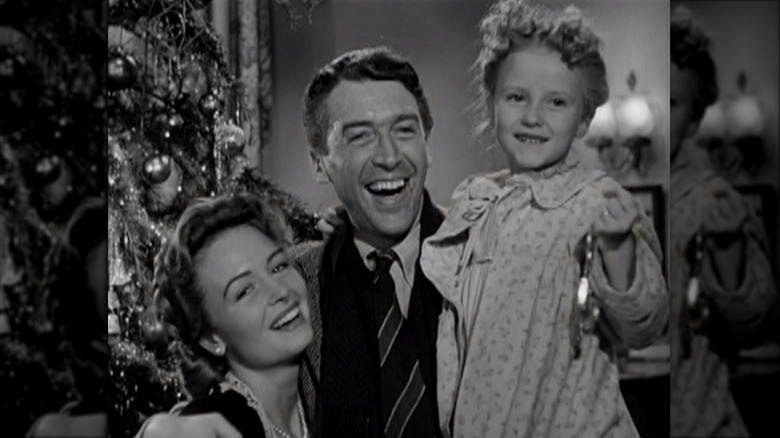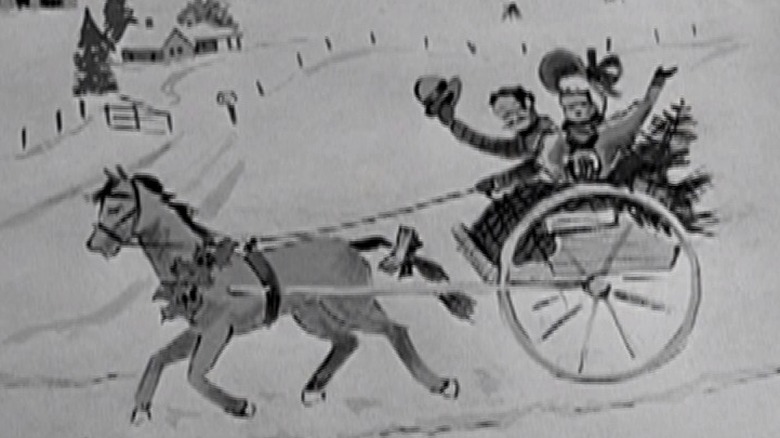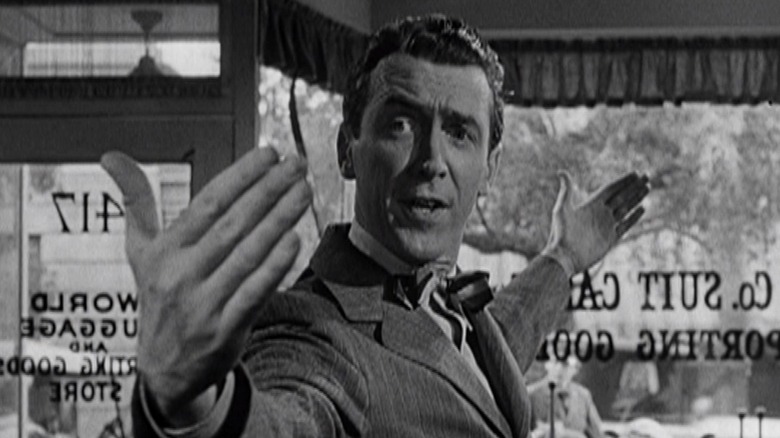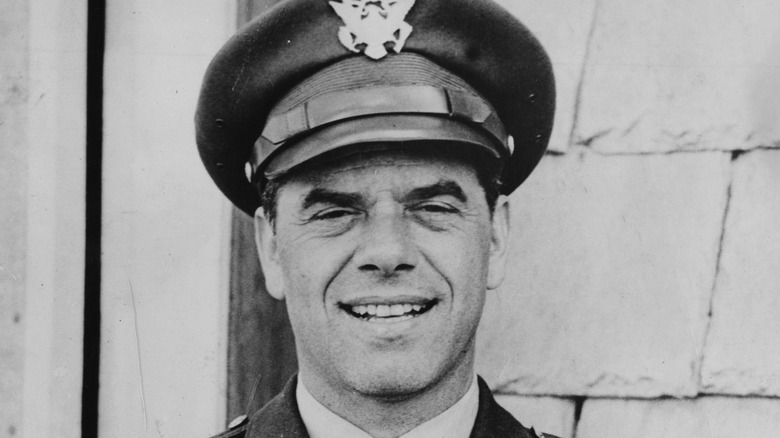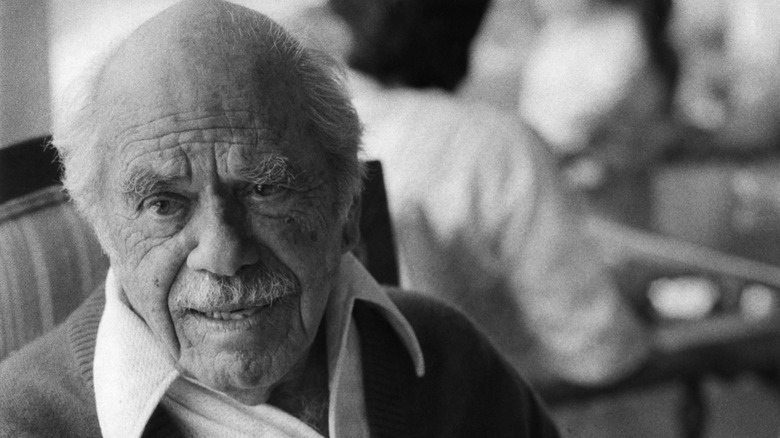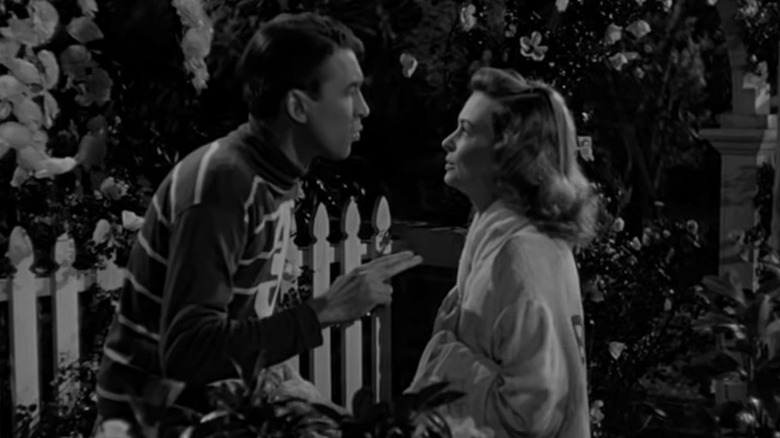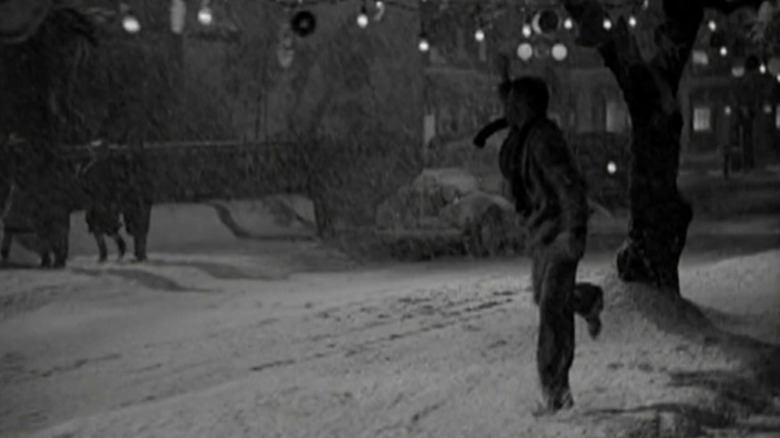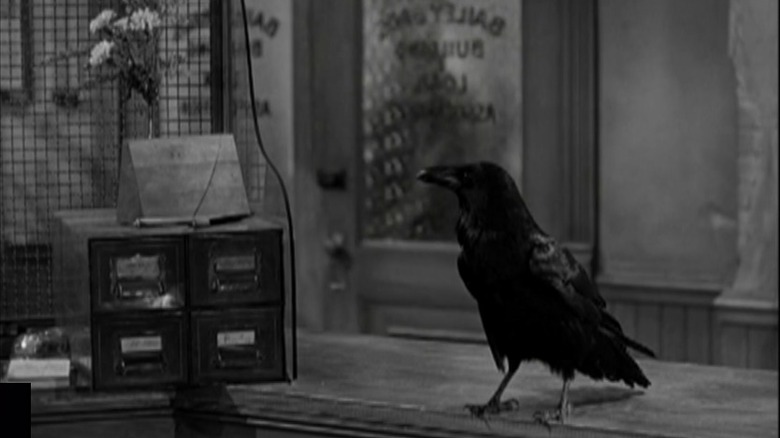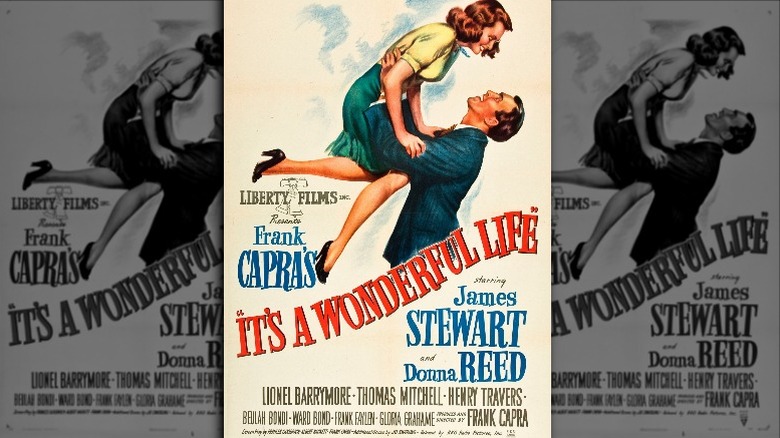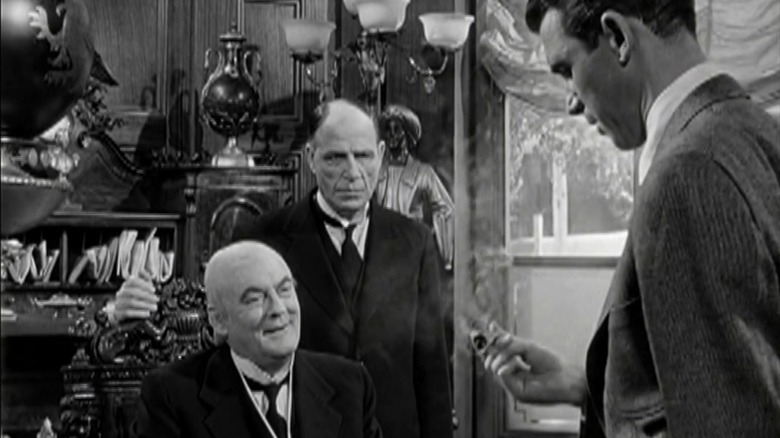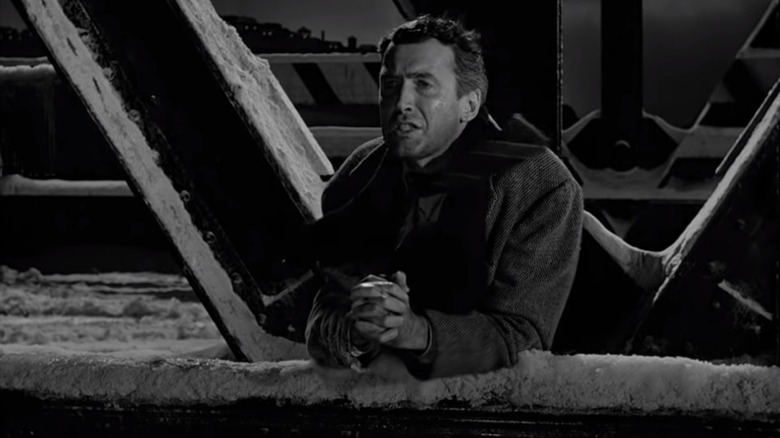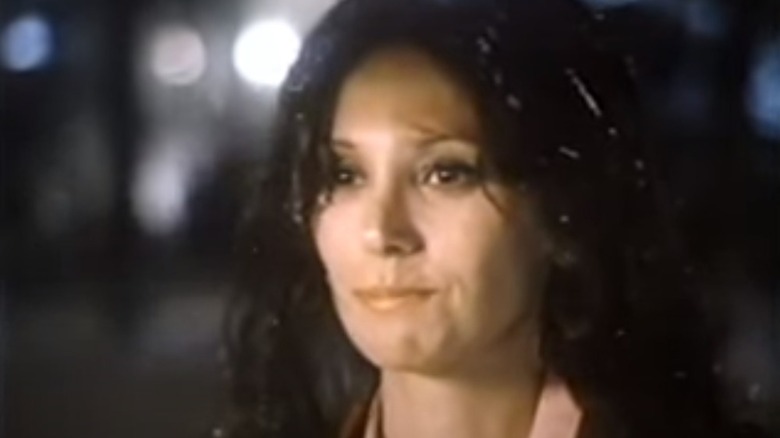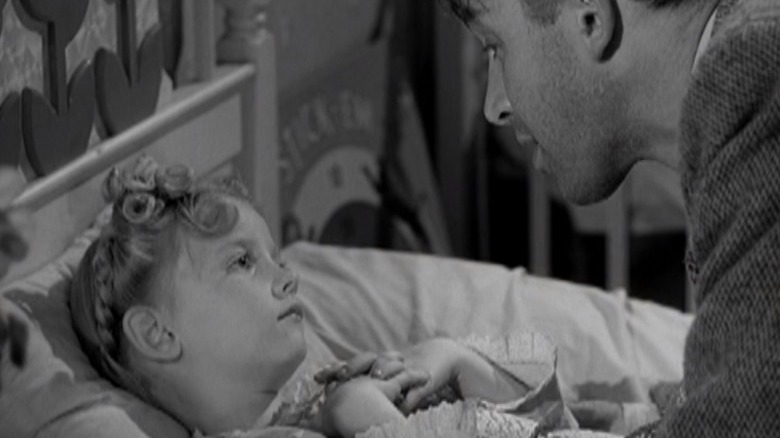The Untold Truth Of It's A Wonderful Life
For the uninitiated, "It's a Wonderful Life" stars Jimmy Stewart as George Bailey, an everyman with big dreams who's hamstrung at every turn by life's obstacles. Forced to take over his father's struggling building and loan, he finds happiness in family life when he weds his childhood sweetheart, Mary Hatch (Donna Reed). However, when $8,000 goes missing on Christmas Eve, George finds himself in desperate straits. Told by family nemesis, rival banker Henry Potter (Lionel Barrymore), he's worth more dead than alive, George decides to end his life. Yet, with the divine intervention of a bumbling angel named Clarence (Henry Travers), George gets a glimpse of a world without him and finds he really has had a wonderful life.
Released to little fanfare the week of Christmas 1946, "It's a Wonderful Life" has gone on to become a beloved staple of the holiday season. With the simple message, "No man is a failure who has friends," Frank Capra's gentle story of one man's search for meaning in the face of crushing adversity continues to resonate with audiences into the 21st century. Teetering on maudlin melodrama, the film nevertheless possesses a sincerity that melts the hearts of the most jaded cynics thanks to a heartfelt performance from lead Jimmy Stewart and a beautifully wrought screenplay.
Although it has become an undisputed Christmas classic, the film's happy ending was decades in the making. This is the untold truth of "It's a Wonderful Life."
Unpublished story to Christmas Card
"It's a Wonderful Life" has some of the most unlikely source material in Hollywood history. As detailed in "The It's a Wonderful Life Book" by Jeanine Basinger, the film's origins lie in a virtually unpublishable short story.
On February 12, 1938, Phillip Van Doren Stern, a Pennsylvania-born Civil War historian, was struck by an idea for a story while shaving. He immediately sat down and drafted a two-page outline about a suicidal man who's visited by an angel. Stern's first few drafts were, in his own words, "pretty terrible." In the spring of 1943, the would-be author took another shot at the story. With the encouragement of his friends, Stern rewrote his manuscript again, this time setting the story at Christmas. Although his agent liked the story, now titled "The Greatest Gift," she warned him that it would be a hard sell. She was right. Stern submitted the story to every outlet from The Saturday Evening Post to local farm journals with no success. Using his own funds, he decided to have the story printed as a 24-page booklet.
In a 1946 feature in the New York Herald Tribune, Stern explained the minor miracle that happened next. "I sent these out to my friends as Christmas cards," Stern explained, "and one of them went to my Hollywood agent. She wrote back asking permission to offer the story to the movies. I thought she was crazy." Three months later, RKO Studios bought "The Greatest Gift” for $10,000.
It's a Wonderful Life languished unrealized
According to "The It's a Wonderful Life Book," Phillip Van Doren Stern's story "The Greatest Gift" sat on the shelves at RKO for some time. Initially, "The Greatest Gift," was intended as a vehicle for dashing leading man Cary Grant. Allegedly, it was Grant who brought the property to RKO's attention. Other sources state that it was producer David Hempstead who brought the "The Greatest Gift" to Grant's agent. Although Grant missed out on snagging Jimmy Stewart's iconic role, he would co-star as a dashing angel in another holiday favorite "The Bishop's Wife" in 1947.
"The Greatest Gift" went through several iterations at RKO. No less than three scripts were written for the proposed film. Among the talent tasked with hammering Stern's "The Greatest Gift" into a viable feature film were Marc Connelly, the Pulitzer Prize-winning screenwriter behind 1937's "Captains Courageous," acclaimed playwright Clifford Odets, and the legendary Dalton Trumbo, who went on to win three Academy Awards. Despite the high caliber of writers assigned to the project, no one could get a handle on Stern's unusual story.
As recounted by author Jeanine Basinger, the trouble was inherent in Stern's overarching idea of a man who gets to see what the world would be like without him. Although that theme remained central to all versions of the script as well as the completed film, the trio of heavyweight screenwriters simply couldn't find a way to effectively weave reality with the story's fantasy elements.
RKO broke even with Frank Capra
Frank Capra was one of the most successful directors of the 1930s and an embodiment of the American Dream. As detailed by biographer Charles J. Maland, Frank Capra and his family emigrated to the United States from Sicily in 1903. By 1922, Capra was working in the film industry as prop man, editor, and gag writer. In just under two decades, Capra went from unemployed son of poor immigrants to Oscar-winning filmmaker.
The day after Pearl Harbor, Capra enlisted in the U.S. Army's Signal Corps. Serving in the Office of War Information, he directed the "Why We Fight" documentaries. With the war's end, Capra was anxious to get back to Hollywood. Before his discharge in 1945, he had already formed a new production company called Liberty Films. Exposed to the horrors of war, Capra returned a changed man, his optimism blunted by what he had witnessed. He knew he needed just the right project relaunch his filmmaking career, one, which according to "The It's a Wonderful Life Book," would reflect his darker post-war feelings, but still be a "Frank Capra comedy."
Capra found his perfect comeback project in "The Greatest Gift," and RKO head Charles Koerner was all too happy to unload the troublesome project. For just $10,000, the exact price the studio had paid Phillip Van Doren Stern, RKO sold Capra's Liberty Films "The Greatest Gift's" story rights, all original material, and the three completed scripts that had been developed for it.
Frank Capra versus the writers
As documented in "The It's a Wonderful Life Book" by Jeanine Basinger, director Frank Capra felt that Van Doren's story contained the right blend of pathos and humor to suit his postwar sensibilities. He also believed that it would be a perfect vehicle for star Jimmy Stewart who had turned in letter-perfect performances in Capra's "Mr. Smith Goes to Washington" and "Mr. Deeds Goes to Town." Stewart had proven he could be funny and also tackle serious themes.
Although Capra's vision coalesced around Stewart, the script for the film that would be renamed "It's a Wonderful Life" remained problematic. To work out the thematic kinks in the story, Capra brought on the husband-and-wife screenwriting team of Frances Goodrich and Albert Hackett. According to author Joseph McBride's "Frank Capra: The Catastrophe of Success," the writing process for "It's a Wonderful Life" was arduous. Along with Hackett and Goodrich, Capra brought on writers Michael Wilson and Jo Swerling to help work on the troublesome script. Algonquin Round Table regular and literary legend Dorothy Parker was drafted to punch up the dialogue.
Unfortunately, Capra's ego tainted the process resulting in much bad blood between the writers. The director's insistence on claiming an onscreen writing credit for himself landed him in a Screenwriters Guild arbitration with his original writing team. In the end, Capra was billed with a writing credit behind Hackett and Goodrich, who were initially unaware that the director was doing scene revisions with Jo Swerling.
The cast that could have been
"It's a Wonderful Life" underwent a challenging search for actors and not even Capra's first choice of Jimmy Stewart seemed guaranteed. As detailed in "The It's a Wonderful Life Book," when Capra explained the script with its fantasy elements to Stewart, the director lost confidence in the material. Despite Capra's 11th hour misgivings, Stewart, also just back from the war and somewhat reluctant to play a suicidal man, was in as long as Capra was in the director's chair.
Finding an actress to play George Bailey's steadfast wife Mary was a headache for Capra. Initially, he offered the role to actress Jean Arthur. Arthur, who had previously appeared in Capra's "Mr. Deeds Goes to Town" and "Mr. Smith Goes to Washington," turned the role down. Later, gossip columnist Hedda Hopper publicly proclaimed that actress and dancer Ginger Rogers was a shoo-in for the role. Capra, however, tapped Donna Reed for the part.
The role of George Bailey's forgetful Uncle Billy eventually went to Thomas Mitchell, but Western actor Walter Brennan and funnyman W.C. Fields were both on Capra's shortlist. Although the role of the scheming Bailey family foe Henry F. Potter went to veteran actor Lionel Barrymore, a number of intriguing alternates were considered for the greedy bank president. Among those under consideration were Claude Rains, Louis Calhern, and Raymond Massey. As revealed in the 1990 documentary "The Making of It's a Wonderful Life," one of the most intriguing choices for Potter was the legendary master of menace Vincent Price.
It's a Wonderful Life's blizzard in June
Fans of "It's a Wonderful Life" no doubt recall the movie's wintery Christmastime scenes. However, when Jimmy Stewart as a renewed George Bailey runs down Main Street in Bedford Falls, New York, exalting, "Merry Christmas!" to all, he's about as far from the winter holiday and the East Coast as one could imagine. As documented in "The It's a Wonderful Life Book," the film began its 90-day shooting schedule on April 8, 1946, hardly the Yuletide season.
The Christmas Eve snowstorm seen at the movie's climax was shot on a June day at RKO's Encino, California ranch. With temperatures climbing into the 90s, one of the largest special effects crews of the era used 250 tons of plaster to construct snow banks and cover tree limbs, powdery gypsum to cover window sills, and 3,000 tons of shaved ice to give the street an appropriately slushy, rutted look.
The film also made use of a new chemical snow composed of soap, water, and foamite, a chemical used in fire extinguishers. Shot out of pressurized canisters, the new snow formula was silent (a huge advantage over the loud, crunchy cornflakes that had been used in previous Hollywood productions) and could be controlled with fans to create everything from gently falling flurries to raging blizzards. As detailed in a 2021 Entertainment Weekly feature, "It's a Wonderful Life's" special effects master Russell Shearman earned a special Oscar for technical achievement for his innovative snow effects in 1949.
The other Jimmy
James Stewart wasn't the only famous Jimmy on the set of "It's a Wonderful Life." Animal actor Jimmy the Raven, who portrayed bumbling Uncle Billy's winged companion, was already a veteran of the silver screen by the time he appeared in the beloved holiday classic. Jimmy became a staple of Capra's films, appearing in most of the director's movies beginning with the 1938 comedy "You Can't Take It With You." In all, the talented raven appeared in hundreds of films including 1939's "The Wizard of Oz."
As detailed in a 1947 issue of "The Sign," Jimmy was owned by animal trainer Curly Twiford, who'd captured the bird in Death Valley, California. An unusually intelligent raven, Jimmy could type his name on a typewriter, smoke a pipe, unlock a padlock, and obey verbal commands.
According to "The It's a Wonderful Life Book," the film's original shooting script unfortunately didn't have a part for Jimmy. However, when Twiford showed up on the set with his brainy bird, Capra wrote Jimmy into the script on the spot as one of Uncle Billy's many animal companions and the mascot of the Bailey Building and Loan. Had Capra gone with his first instinct, Jimmy might have had a bigger part. In one of Capra's handwritten notes, he outlined a scene in which Lionel Barrymore's villainous Potter would be pecked by Jimmy and need to be rushed to the Bedford Falls drug store for treatment.
It was a tremendous flop
As documented by Jeanine Basinger, "It's a Wonderful Life" was originally scheduled to go into general release on January 30, 1947. However, when a strike by workers at Technicolor prevented RKO from releasing prints of their swashbuckler "Sinbad the Sailor," the distributor moved Capra's film into its prime holiday slot. Although Capra didn't intend for "It's a Wonderful Life" to be regarded exclusively as a holiday film, he pressed forward with RKO's last-ditch plan. A December release would also ensure the film would be eligible for the following year's Academy Awards.
The film failed to connect with audiences. Despite Capra's status as one of Hollywood's most popular and profitable directors and Jimmy Stewart's seemingly unassailable star power, "It's a Wonderful Life" was a box office disappointment. Although it had a relatively strong opening, receipts dropped dramatically after the holidays. As detailed in a 2020 retrospective in the Independent, the critics proved no kinder to the film. The New York Times' review cited the film's sentimentality as a weakness, calling Stewart's George Bailey a "figment of simple Pollyanna platitudes." The New Republic's Manny Farber accused Capra of insulting his audience's intelligence by taking "an easy simple-minded path."
Still, "It's a Wonderful Life" was nominated for five Academy Awards including nods for Best Picture, Best Actor, and Best Director. Sadly, Capra and company walked away from the Oscars empty handed. By the year's end, "It's a Wonderful Life" had placed 26th in box office revenues bringing in a reported loss of $525,000 for RKO.
Wholesome entertainment or Communist propaganda?
It's hard to imagine a film steeped more in traditional family values than "It's a Wonderful Life." Nevertheless, the holiday classic ran afoul of an FBI program to root out Communist propaganda in entertainment for its allegedly subversive elements.
As documented in "J. Edgar Hoover Goes to the Movies: The FBI and the Origins of Hollywood's Cold War" by John Sbardellati, FBI informants claimed that Capra's heartwarming holiday classic subverted unsuspecting audiences by encouraging class consciousness and setting them on a slippery slope to socialism. In a document released under the Freedom of Information Act, an unnamed FBI special agent wrote, "the film represented a rather obvious attempt to discredit bankers by casting Lionel Barrymore as a 'Scrooge-type' so that he would be the most hated man in the picture ... a common trick used by the Communists."
The FBI document also cites screenwriters Frances Goodrich (incorrectly noted as Goodrick) and Albert Hackett as having being seen "eating luncheon daily" with other "known Communists" including writer Lester Cole, one of the infamous Hollywood Ten who faced blacklisting for refusing to testify before Congress for alleged involvement in the Communist Party, and folk music composer and arranger Earl Robinson, known for setting the pro-labor poem "Joe Hill" about the eponymous union activist to music.
It took decades to find its audience
When "It's a Wonderful Life" completed its lackluster theatrical run in 1947, most, including director Frank Capra and star Jimmy Stewart, assumed that the film had run its course. Disappointed but feeling he had achieved what he had set out to do in bringing Phillip Van Doren Stern's "The Greatest Gift" to the screen, Capra moved on to his next project and "It's a Wonderful Life" was consigned to Hollywood history as a footnote in a great director's career.
Yet, just under three decades later, a miracle worthy of Clarence the angel himself brought new life to the forgotten flick. As detailed by the BBC, in 1974, Republic Pictures failed to renew its copyright and "It's a Wonderful Life" fell into the public domain. TV programmers, always on the lookout for cheap content to fill airtime in the pre-infomercial 1970s, snagged the film for holiday season filler. Repeated royalty-free TV airings exposed a new generation to the story of George Bailey and "It's a Wonderful Life" became as synonymous with Christmas as Santa Claus and Rudolph the Red-nosed Reindeer. In "The It's a Wonderful Life Book," author Jeanine Basinger recounts Capra's reaction to the Yuletide TV phenomenon. "I woke up one Christmas morning and the whole world was watching 'It's Wonderful Life,'" Capra told a crowd of Wesleyan University film students.
A gender-swapped 1977 remake
A close retelling of the events of "It's a Wonderful Life," the 1977 ABC television movie "It Happened One Christmas" features Marlo Thomas as Mary Bailey Hatch, a female analog to Jimmy Stewart's George Bailey. Many scenes in "It Happened One Christmas" are nearly shot-for-shot recreations of sequences from "It's a Wonderful Life" with large swaths of dialogue lifted verbatim from Capra's 1946 film.
Largely forgotten, "It Happened One Christmas" nonetheless had a star-studded cast, with Cloris Leachman stepping into the angelic shoes of Henry Travers' as Clara Oddbody, MASH's Wayne Rogers as Mary's husband George Hatch, and a supremely malignant Orson Welles as Henry F. Potter.
As documented by Turner Classic Movies, "It Happened One Christmas," garnered an Emmy nomination for Leachman as well as a nomination for art direction. It was also a ratings hit for ABC. Less impressed was director Frank Capra, who called the production out for plagiarism.
Zuzu Lives!
Portraying the youngest Bailey child Zuzu, 6-year-old Karolyn Grimes plucked millions of heartstrings when she chirped the iconic line, "Every time a bell rings, an angel gets his wings."
Sadly, Grimes' own life was anything but wonderful. When she was 12, her mother died from complications of early-onset Alzheimer's. Three years later, her father was killed in an auto accident. "The court sent me to live with my uncle and aunt in Missouri," Grimes told The Washington Post. "They were kind of nutso religious fanatics who didn't believe in movies, dancing, singing ... I don't think they believed in laughing, either."
Now in her 80s, Grimes keeps "It's a Wonderful Life's" legacy alive by making appearances at yearly events celebrating the film. She also penned "Zuzu Bailey's 'It's a Wonderful Life' Cookbook," which contains such Bedford Falls-inspired recipes as Clarence Oddbody's Heavenly Hot Mulled Wine and Henry Potter Pot Pie.
